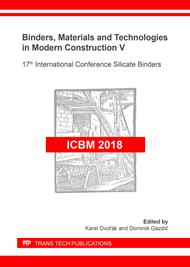[1]
J. Davidovits, Geopolymer chemistry and application, 3rd editon, Institute Geopolymer, France, (2011).
Google Scholar
[2]
J.L. Provis and J.S.J. van Deventer, Alkali Activated Materials: State of the art report. RILEM-TC244 AAM, Springer Dordrecht Heidelberg New York London, (2014).
DOI: 10.1007/978-94-007-7672-2
Google Scholar
[3]
H.T. Nguyen, T.K. Pham, and M.M.A.B. Abdullah, Lightweight Heat Resistant Geopolymer-based Materials Synthesized from Red Mud and Rice Husk Ash Using Sodium Silicate Solution as Alkaline Activator, MATEC Web Conferences 97, 011019 (2017).
DOI: 10.1051/matecconf/20179701119
Google Scholar
[4]
V.Q. Le, M.Q. Do, M.D. Hoang, T.P. Dang, T.H. Bui, H.T. Nguyen, Evaluation on Roles of Activated Silicon and Aluminum Oxides for Formation of Geopolymer from Red Mud and Silica Fume, Key Engineering Materials, 777 (2018) 513-517.
DOI: 10.4028/www.scientific.net/kem.777.513
Google Scholar
[5]
H.T. Nguyen, T.K Pham, M.A.B. Promentilla, Development of Geopolymer-Based Materials from Coal Bottom Ash and Rice Husk Ash with Sodium Silicate Solutions, Lecture Notes in Civil Engineering 8 (2018) 402-410.
DOI: 10.1007/978-981-10-6713-6_40
Google Scholar
[6]
H.T. Nguyen, H.L.N. Nguyen, T.N.U. Vo, T.K. Pham, Novel materials synthesized from red mud, bagasse, and bentonite for gas treatment by CO2 absorption, MATEC Web of conferences 207, 03005 (2018). https://doi.org/10.1051/matecconf/201820703005.
DOI: 10.1051/matecconf/201820703005
Google Scholar
[7]
M.E.L. Kalaw, A.B. Culaba, H.T. Nguyen, K. Nguyen, H. Hinode, W. Kurniawan, S.M. Gallardo, M.A.B. Promentilla, Mechanical and Thermal Properties of Geopolymers from Mixtures of Coal Ash and Rice Hull Ash using Water Glass Solution as Activator, ASEAN Journal of Chemical Engineering 15 (2015) 57-65.
DOI: 10.22146/ajche.49686
Google Scholar
[8]
A.K.R. Sumabat, A.J. Manalac, H.T. Nguyen, M.E. Kalaw, R.R. Tan, M.A.B. Promentilla, Optimizing geopolymer-based material for industrial application with analytic hierarchy process and multi-response surface analysis, Chemical Engineering Transaction 45 (2015) 1147-1152.
Google Scholar
[9]
T.K. Pham, T.T.L. Tran, T.L.T. Pham, P.Q.N. Tran, H.T. Nguyen, M.M.A.B. Abdullah, A Novel Study on Using Vietnam Rice Hush Ash and Cullet as Environmental Materials, MATEC Web of Conferences 97, 011020 (2017).
DOI: 10.1051/matecconf/20179701118
Google Scholar
[10]
H.T. Nguyen, T.N. Le, V.T.H.Q. Pham, T.P. Dang, T.K. Dao, V.P. Nguyen, Development of heat resistant geopolymer-based materials from red mud and rice husk ash, AIP Conference Proceedings, 1954, 040005 (2018). https://doi.org/10.1063/1.5033405.
DOI: 10.1063/1.5033414
Google Scholar
[11]
H.T. Nguyen, N.H. Nguyen, V.T.H.Q. Pham, N.K.T. Nguyen, V.T.A. Tran, T.K. Pham, Engineering properties of lightweight geopolymer synthesized from coal bottom ash and rice husk ash, AIP Conference Proceedings, 1954, 040009 (2018). https://doi.org/10.1063/1.5033409.
DOI: 10.1063/1.5033414
Google Scholar
[12]
H.T. Nguyen, V.T.H.Q. Pham, T.P. Dang, T.K. Dao, Leachability of heavy metals in geopolymer-based materials synthesized from red mud and rice husk ash, AIP Conference Proceedings, 1954, 040014 (2018). https://doi.org/10.1063/1.5033414.
DOI: 10.1063/1.5033414
Google Scholar
[13]
M.A.B. Promentilla, M.E.L. Kalaw, H.T. Nguyen, K.B. Aviso, R.R. Tan, A Fuzzy Programming Approach to Multi-Objective Optimization for Geopolymer Product Design, Computer Aided Chemical Engineering 40 (2017) 1015-1020.
DOI: 10.1016/b978-0-444-63965-3.50171-9
Google Scholar
[14]
V.Q. Le, M.Q. Do, M.D. Hoang, V.T.H.Q. Pham, T.H. Bui, H.T. Nguyen, Effect of Alkaline Activators to Engineering Properties of Geopolymer - Based Materials Synthesized from Red Mud Key Engineering Materials, 777 (2018) 508-512.
DOI: 10.4028/www.scientific.net/KEM.777.508
Google Scholar
[15]
H.T. Nguyen, T.H. Bui, V.T.H.Q. Pham, M.Q. Do, M.D. Hoang, V.Q. Le, Leaching Behavior and Immobilization of Heavy Metals in Geopolymer Synthesized from Red Mud and Fly Ash, Key Engineering Materials, 777 (2018) 518-522.
DOI: 10.4028/www.scientific.net/KEM.777.518
Google Scholar
[16]
H.T. Nguyen, V.T.H.Q. Pham T.N. Le, T.P. Dang, N.K.T. Nguyen, Utilization of red mud and bagasse for production of gas absorption materials, AIP Conference Proceedings 1954, 040010 (2018). https://doi.org/10.1063/1.5033410.
Google Scholar


